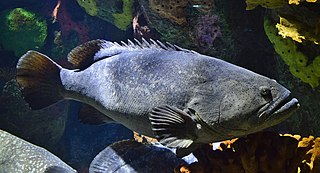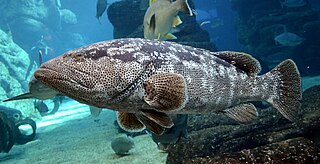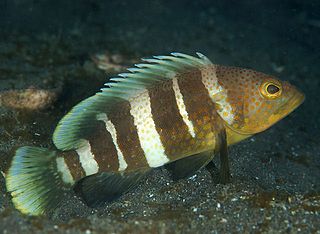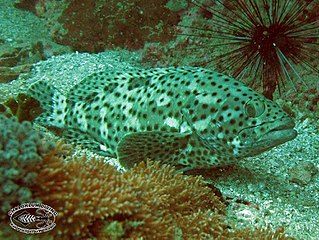
Epinephelus is a genus of marine ray-finned fish, groupers from the subfamily Epinephelinae, part of the family Serranidae, which also includes the anthias and sea basses. They are predatory fish, largely associated with reefs and are found in tropical and subtropical seas throughout the world. They are important target species for fisheries.

The giant grouper (Epinephelus lanceolatus), also known as the Queensland groper (grouper), brindle grouper or mottled-brown sea bass, is a species of marine ray-finned fish, a grouper from the subfamily Epinephelinae which is part of the family Serranidae, which also includes the anthias and sea basses. It has a wide Indo-Pacific distribution and is one of the largest extant species of bony fish.

The brownspotted grouper, also known as the brown spotted reef cod, brown-spotted rockcod, coral grouper or honeycomb cod, is a species of marine ray-finned fish, a grouper from the subfamily Epinephelinae which is part of the family Serranidae, which also includes the anthias and sea basses. It has an Indo-Pacific distribution but in the northern Indian Ocean this distribution is discontinuous. It forms part of a species complex with two closely related species in the genus Epinephelus.

The Malabar grouper also known as blackspot rockcod, estuary rockcod, giant rock cod, greasy grouper, Malabar rockcod, Morgan's cod or speckled grouper, is a species of marine ray-finned fish, a grouper from the subfamily Epinephelinae which is part of the family Serranidae, which also includes the anthias and sea basses. It is found in the Indo-Pacific region. It has entered the Mediterranean Sea from the Red Sea by way of the Suez Canal as a Lessepsian migrant.

The blacktip grouper, also known as the redbanded grouper, blacktipped cod, black-tipped rockcod, footballer cod, red-barred cod, red-barred rockcod, scarlet rock-cod or weathered rock-cod, is a species of marine ray-finned fish, a grouper from the subfamily Epinephelinae which is part of the family Serranidae, which also includes the anthias and sea basses. It is found in the tropical Indo-Pacific region. It is the type species of the genus Epinephelus.

Epinephelus albomarginatus, the white-edged grouper, white-edged rockcod or captain fine, is a species of marine ray-finned fish, a grouper from the subfamily Epinephelinae which is part of the family Serranidae, which also includes the anthias and sea basses. It is found in the southwestern Indian Ocean and it is associated with coral reefs. It is a target species for commercial and recreational fisheries.

Epinephelus andersoni, the catface grouper, brown-spotted grouper, catface rockcod or brown spotted rockcod, is a species of marine ray-finned fish, a grouper from the subfamily Epinephelinae which is part of the family Serranidae, which also includes the anthias and sea basses. It is found in the southwestern Indian Ocean where it is associated with reefs.

The yellow grouper, also known as the banded grouper, is a species of marine ray-finned fish, a grouper from the subfamily Epinephelinae which is part of the family Serranidae, which also includes the anthias and sea basses. It is found in eastern Asian waters of the Western Pacific Ocean. Its natural habitats are shallow seas and rocky reefs.

The orange-spotted grouper, also known as the brown-spotted rockcod, estuary cod, estuary rockcod, goldspotted rockcod, greasy cod, North-west groper, orange spotted cod or blue-and-yellow grouper, is a species of marine ray-finned fish, a grouper from the subfamily Epinephelinae which is part of the family Serranidae, which also includes the anthias and sea basses. It has an Indo-Pacific distribution and is found in marine and brackish waters.

The potato grouper, also called the potato cod or potato bass, is a species of marine ray-finned fish, a grouper from the subfamily Epinephelinae which is part of the family Serranidae, which also includes the anthias and sea basses. It has a wide Indo-Pacific distribution.

Cephalopholis miniata, also known as the coral grouper, coral hind, coral rock cod, coral cod, coral trout, round-tailed trout or vermillion seabass is a species of marine ray-finned fish, a grouper from the subfamily Epinephelinae which is in the family Serranidae which also includes the anthias and sea basses. It is associated with coral reefs and occurs in the Indo-Pacific.

Plectropomus laevis, known commonly as the black-saddled coral grouper, cluespotted coral trout, blacksaddled coral trout, blue-spot trout, Chinese footballer, footballer cod, footballer coral trout, oceanic coral trout or tiger trout, is a species of marine ray-finned fish, a grouper from the subfamily Epinephelinae which is part of the family Serranidae, which also includes the anthias and sea basses. It is found in the Indo-Pacific region.

The areolate grouper, also known as the yellowspotted rockcod, areolate rockcod, green-spotted rock-cod, squaretail grouper or squaretail rock-cod, is a species of marine ray-finned fish, a grouper from the subfamily Epinephelinae which is part of the family Serranidae, which also includes the anthias and sea basses. It inhabits coral reefs in the Indo-Pacific region. They are produced through aquaculture and commercially fished. They currently face no threats to their survival.

The longfin grouper, also known as the longfin rockcod, bar-breasted rock-cod, Gilbert's rock-cod, honeycomb rockcod, spotted groper or wirenet cod, is a species of marine ray-finned fish, a grouper from the subfamily Epinephelinae which is part of the family Serranidae, which also includes the anthias and sea basses. It is found in the Western Pacific Ocean.

Epinephelus spilotoceps, the foursaddle grouper or spotty cod, is a species of marine ray-finned fish, a grouper from the subfamily Epinephelinae which is part of the family Serranidae, which also includes the anthias and sea basses. It is found in the Indo-Pacific region.

Epinephelus ongus, the white-streaked grouper, specklefin grouper, lace-finned rock-cod, specklefin rockcod, wavy-lined tock-cod, white-speckled grouper or white-spotted rock-cod, is a species of marine ray-finned fish, a grouper from the subfamily Epinephelinae which is part of the family Serranidae, which also includes the anthias and sea basses. It has a wide Indo-Pacific distribution and it is found in brackish waters as well as marine reefs.

Epinephelus corallicola, also known as the black-dotted cod, coral cod, coral rockcod or duskyfin grouper, is a species of marine ray-finned fish, a grouper from the subfamily Epinephelinae which is part of the family Serranidae, which also includes the anthias and sea basses. It has an Indo-Pacific distribution and is found in marine and brackish waters.

Epinephelus maculatus, the highfin grouper, blackfin cod or brown-spotted rock-cod, marbled rock-cod or spotted grouper, is a species of marine ray-finned fish, a grouper from the subfamily Epinephelinae which is part of the family Serranidae, which also includes the anthias and sea basses. It is found in the Indo-Pacific region.

Epinephelus rivulatus, the halfmoon grouper, halfmoon rockcod, Chinaman rockcod, Charlie court cod, green-finned rock cod, or white-dotted grouper, is a species of marine ray-finned fish, a grouper from the subfamily Epinephelinae which is part of the family Serranidae, which also includes the anthias and sea basses. It is found in the Indo-Pacific region.

Cephalopholis sonnerati, known as the tomato hind, tomato rockcod, or tomato cod, is a species of marine ray-finned fish, a grouper from the subfamily Epinephelinae which is in the family Serranidae which also includes the anthias and sea basses. It is distributed on coral reefs in the tropical Indo-Pacific. It is also sometimes called the orange-spotted cod, red coral cod, red rockcod, tomato grouper, or tomato seabass.
























